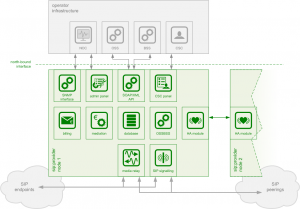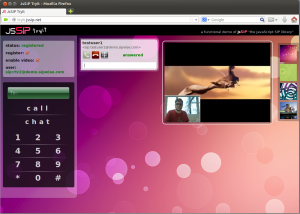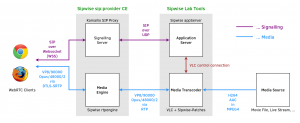We are excited to announce the general availability of sip:providerCE mr3.3.2 and sip:providerPRO mr3.3.2, aka the next build of release v3.3 Version.
What’s the sip:provider platform?
![sppro_overview sip:provider PRO Architecture Overview]()
The Sipwise sip:provider platform is a highly versatile open source based VoIP soft-switch for ISPs and ITSPs to serve large numbers of SIP subscribers. It leverages existing building blocks like Kamailio, Sems and Asterisk to create a feature-rich and high-performance system by glueing them together in a best-practice approach and implementing missing pieces on top of it.
Sipwise engineers have been working with Asterisk and Kamailio (and its predecessors SER and OpenSER) since 2004, and have roles on the management board of Kamailio and are contributing to these projects both in terms of patches and also financially by sponsoring development tasks. The sip:provider platform is available as a Community Edition (SPCE), which is fully free and open source, and as a commercial PRO appliance shipped turn-key in a high availability setup.
The SPCE provides secure and feature-rich voice and video communication to end customers (voice, video, instant messaging, presence, buddy lists, file transfer, screen sharing, remote desktop control) and connect them to other SIP-, Mobile- or traditional PSTN-networks. It can therefore act as open Skype replacement system, traditional PSTN replacement, Over-The-Top (OTT) platform and also as a Session Border Controller in front of existing VoIP services in order to enable signaling encryption, IPv6 support, fraud- and Denial-of-Service prevention. Another use-case is to act as a Class4 SIP concentrator to bundle multiple SIP peerings for other VoIP services.
What’s new in mr3.3.2?
The build mr3.3.2 contains the set of fixes for release mr3.3. No new features added to mr3.3.2. See the full list of changes at the end of the announce.
How do I test-drive the new version?
As usual, we’re providing a VMWare Image, a Virtualbox Image and a Vagrant Box for quick evaluation testing. Check the relevant section in the Handbook for detailed instructions.
How do I install the new version or upgrade from an older one?
For new users, please follow the Installation Instructions in the Handbook to set up the SPCE mr3.3.2 from scratch.
For users of the SPCE mr3.2.x, please follow the upgrade procedure outlined in the Handbook. If you have customized your configurations using customtt.tt2 files, you must migrate your changes to the new configuration files after the upgrade, otherwise all your calls will most certainly fail.
How can I contribute to the project?
Over the last months we’ve started to publish our software components at github.com/sipwise. This is still an on-going effort, which is done on a component-per-component basis. Please check back regularly for new projects to appear there, and feel free to fork them and send us pull requests. For development related questions, please subscribe to our SPCE-Dev Mailing-List at lists.sipwise.com/listinfo/spce-dev.
What’s coming up next?
The mr3.3.2 build is stabilization/bugfixes build, so contains no new features. For the upcoming mr3.4.1 we’re preparing the system for a new LTS version, so it will mainly be optimization and bug fixing. Nonetheless, we’re currently working on Event Detail Records (compared to Call Detail Records), so you could charge customers based on the features they are using instead of the calls, allowing for attractive product modeling. Also, there will be some further enhancements to the REST-API, so any feedback on the current state is highly appreciated, as it is the first version we consider stable and feature-complete. The SOAP/XMLRPC API does not receive any new features anymore, so this is a good time to consider switching to the new API.
Acknowledgements
We want to thank our PRO customers and the SPCE community for their feedback, bug reports and feature suggestions to make this release happen. We hope you enjoy using the mr3.3.2 build and keep your input coming. A big thank you also to all the developers of Kamailio, Sems and Prosody, who make it possible for us to provide an innovative and future-proof SIP/XMPP engine as the core of our platform! And last but not least a HUGE thank you to the Sipwise development team, who worked insanely hard to create this release. You are awesome!
Full Changelog of Bugfixes and Enhancements
MT#8259 Mediaproxy session is not destroyed in ROUTE_STOP_RTPPROXY_BRANCH
MT#8247 Search sipstats by UUID fails
MT#8171 Asterisk/ngcpcfg.services doesn’t check active node [PRO only]
MT#8121 Incoming calls interrupted after 90 upto 180 seconds
MT#8093 Fix instructions for downloading ngcp-installer in 3.x handbooks
MT#8065 Problem with billing profile changing
MT#7995 Using E.164 internally instead of local numbering
MT#7993 Fixed ntp.conf, ntpd didn’t work
MT#7981 Changing admin flag for subscribers not possible in admin panel
MT#7959 REST API: contracts creation require property “type”
MT#7927 Cannot SSH system using cdrexport account (su: Cannot determine your user name.)
MT#7901 Upgrade 3.1=>mr3.2.2: strange heartbeat behavior at the end of upgrade process [PRO only]
MT#7867 Logo inside PDF invoice can’t be changed
MT#7861 Fix for invoice template creation
MT#7843 “VAT Rate” and “VAT included” missed from Billing Fees
MT#7841 API: Improve documentation on callforwards
MT#7803 Show invoice links and sections in panel
MT#7797 API: allow to filter for customer status
MT#7785 Rewrite rules are not engaged for 302 redirect from pbx users
MT#7783 Proxy to support multi-value Privacy header
MT#7737 Action methods (begin) found defined in your application class
MT#7731 Can’t see/create soundset as a reseller
MT#7717 Domain are present in DB but not in GUI
MT#7715 Failover problem on calls from PBX to PSTN
MT#7713 Auto Attendant Slot menu is available for Standard SIP account (not pbx) user preferences
MT#7685 Provisioning.wsdl – add ‘nilable’ flag into SubscriberPreferencesRead
MT#7683 SOAP – fixed data types
MT#7655 No Edit button on Cloud PBX subscribers preferences mr3.2.2
MT#7647 Hylafax templates – minor fixes
MT#7645 Diva-drivers adaptation for kernel 3.13
MT#7631 Hb_watchdog switch back active node if it checks in the same second of manual switching [PRO only]
MT#7595 Reloading sound file doesn’t work – move sw_audio_api.dsm from callingcard to templates package
MT#7585 Documentation about administrator user/passwd + panel
MT#7579 Disable binlog cleanup for Vagrant VMs
MT#7573 Upgrade script should cleanup old core files
MT#7569 Per-call CLIR is broken for PBX subscribers
MT#7557 REST API: unable to change pbx extension of a subscriber
MT#7495 Implement contract preference ncos and block handling
MT#7493 NGCP Panel do not show Auto Attendant destination as option for Call Forwarding
MT#7471 Introduce contract preferences
MT#7455 P-* headers are duplicated in ROUTE_EXECUTE_CF_LOOP on hunting
MT#7417 Monit: heartbeat failover lasts more than 30 seconds [PRO only]
MT#7407 Move sems option media_processor_threads to config.yml
MT#7399 Create sems cache directory
MT#7355 Sems restart sometimes exits with non-zero exit code (missed –oknodo)
MT#7351 Hylafax – force set enveloper-from
MT#7137 Deployment.sh doesn’t rebuild configs for adjust_for_low_performance mode
MT#6705 Make clir preference more flexible
MT#6693 Ngcp-panel: implement subscriber profiles for subscriber csc feature control
MT#6135 Snmpd doesn’t start on inactive node [PRO only]
MT#5879 Set of fixes for PDF Invoice generation














 LCON:
LCON:





